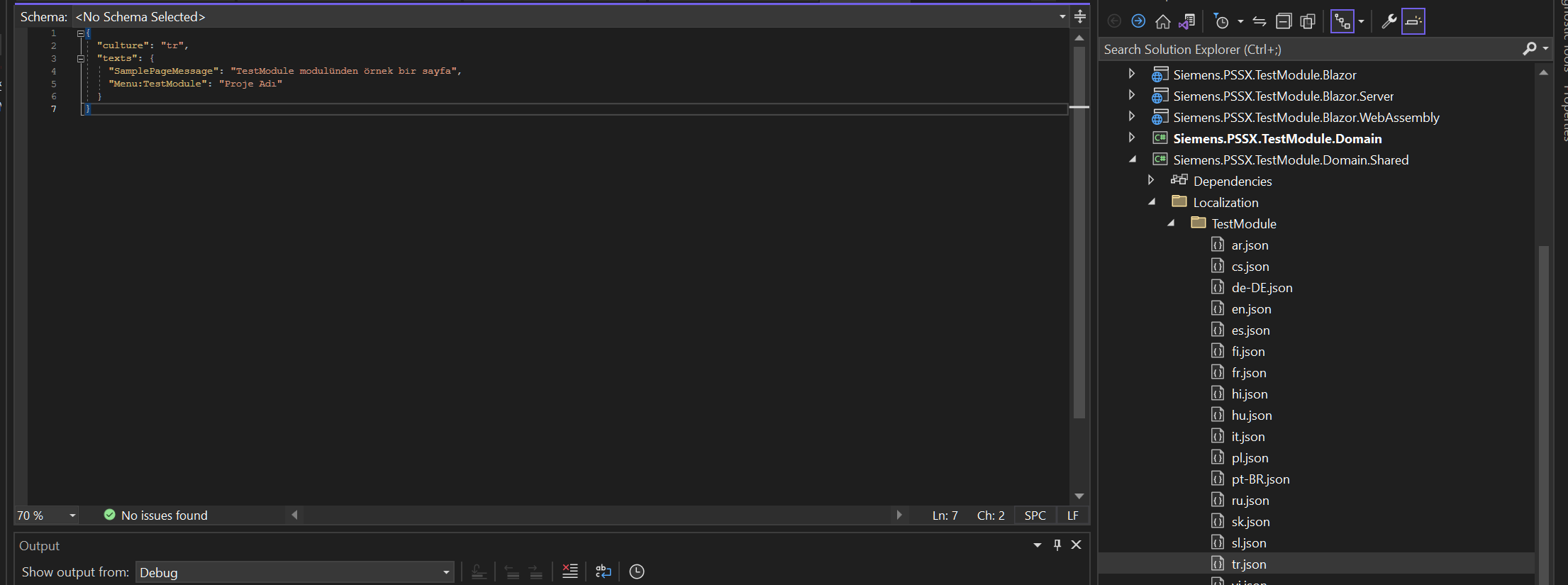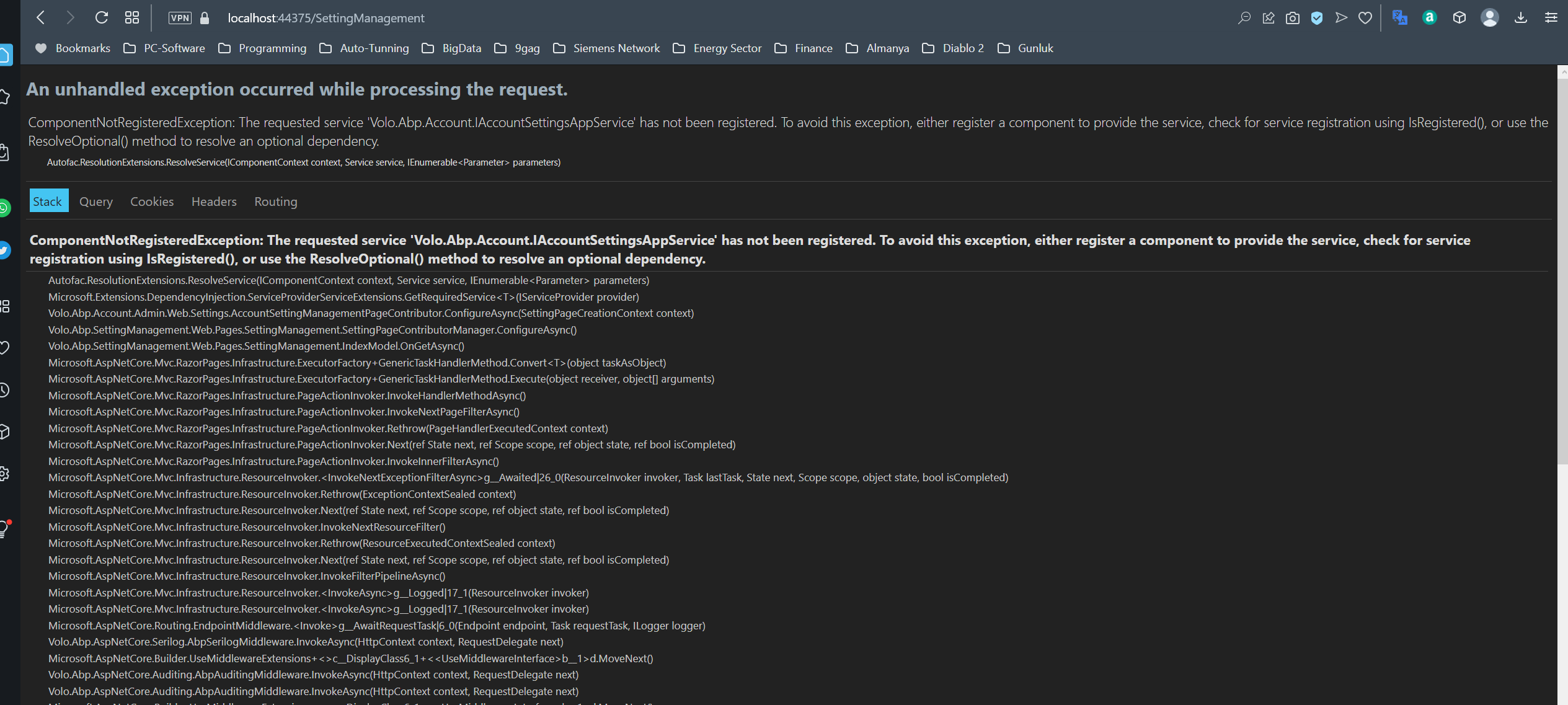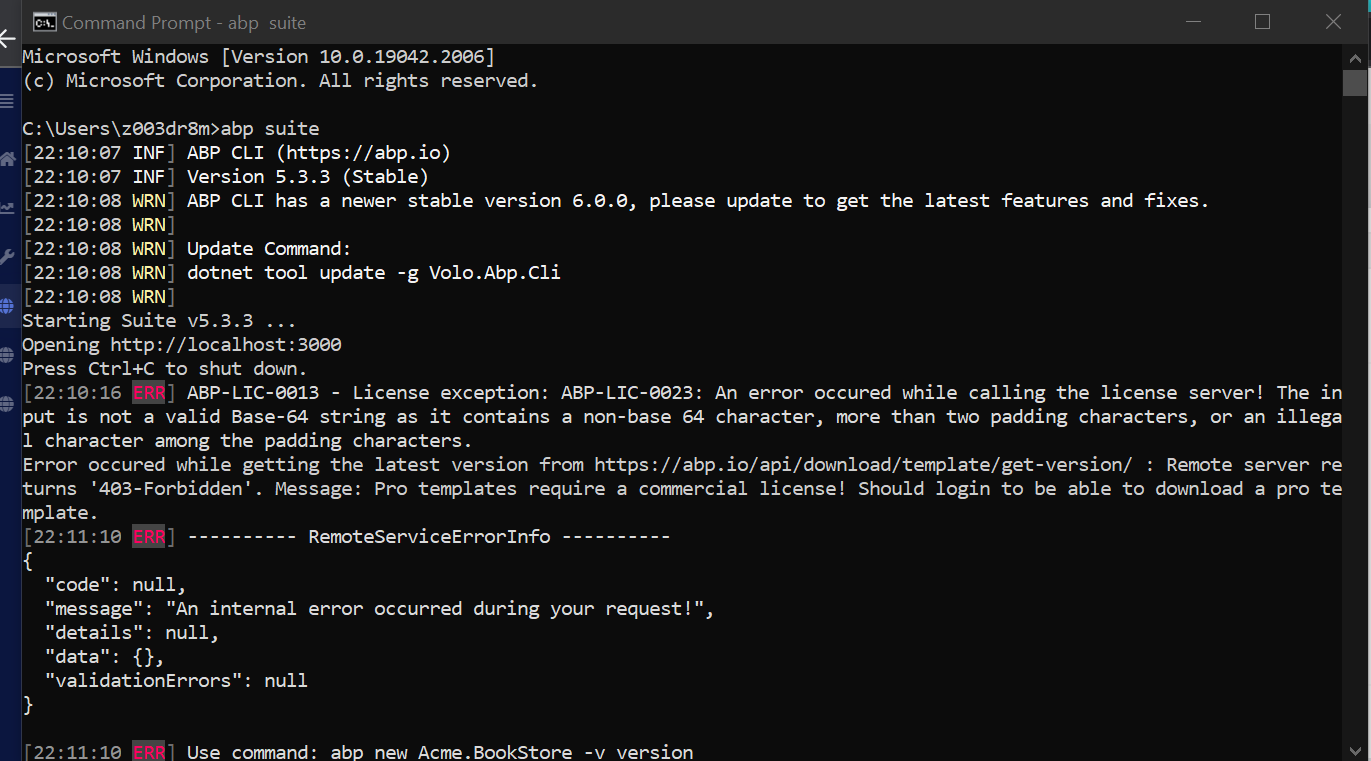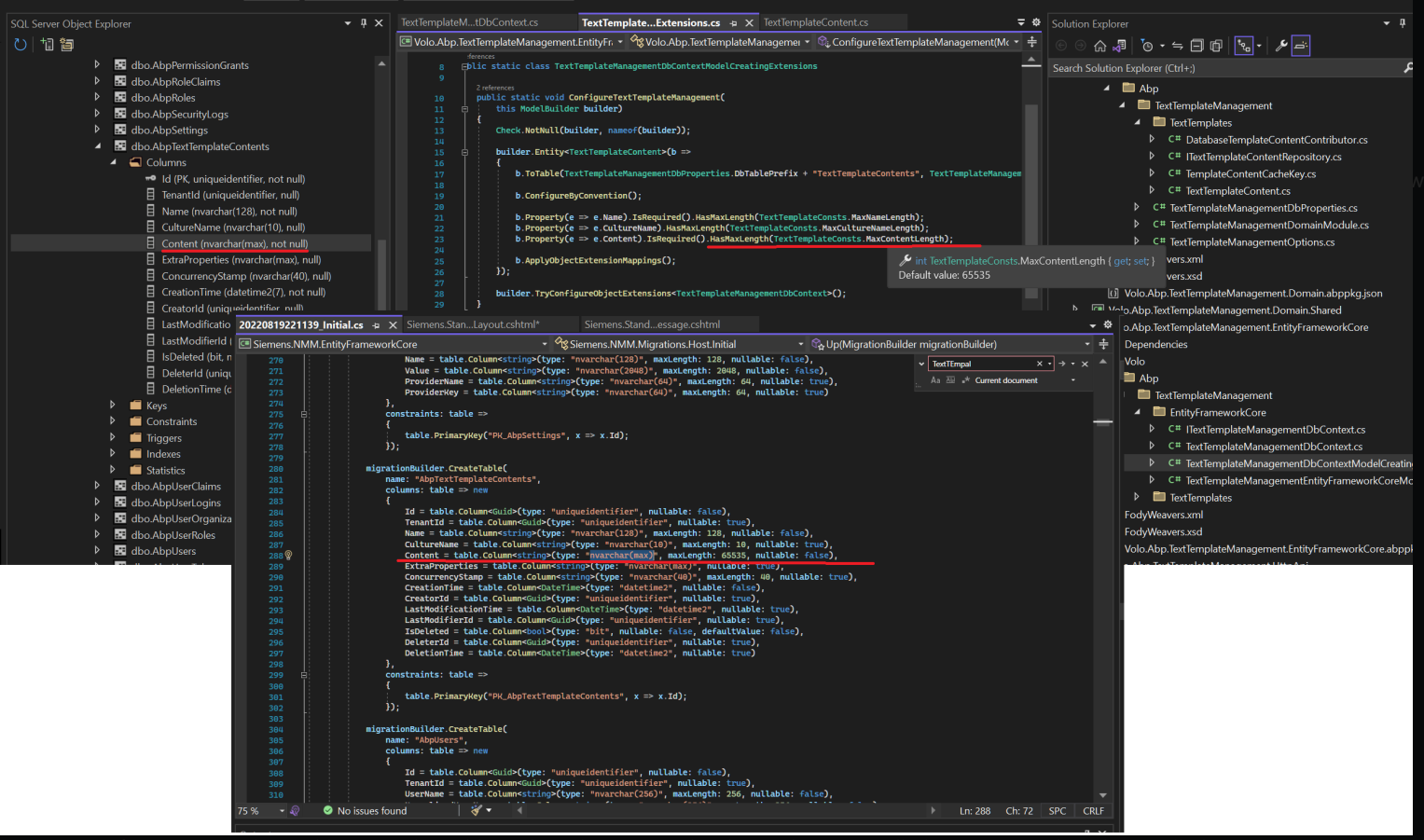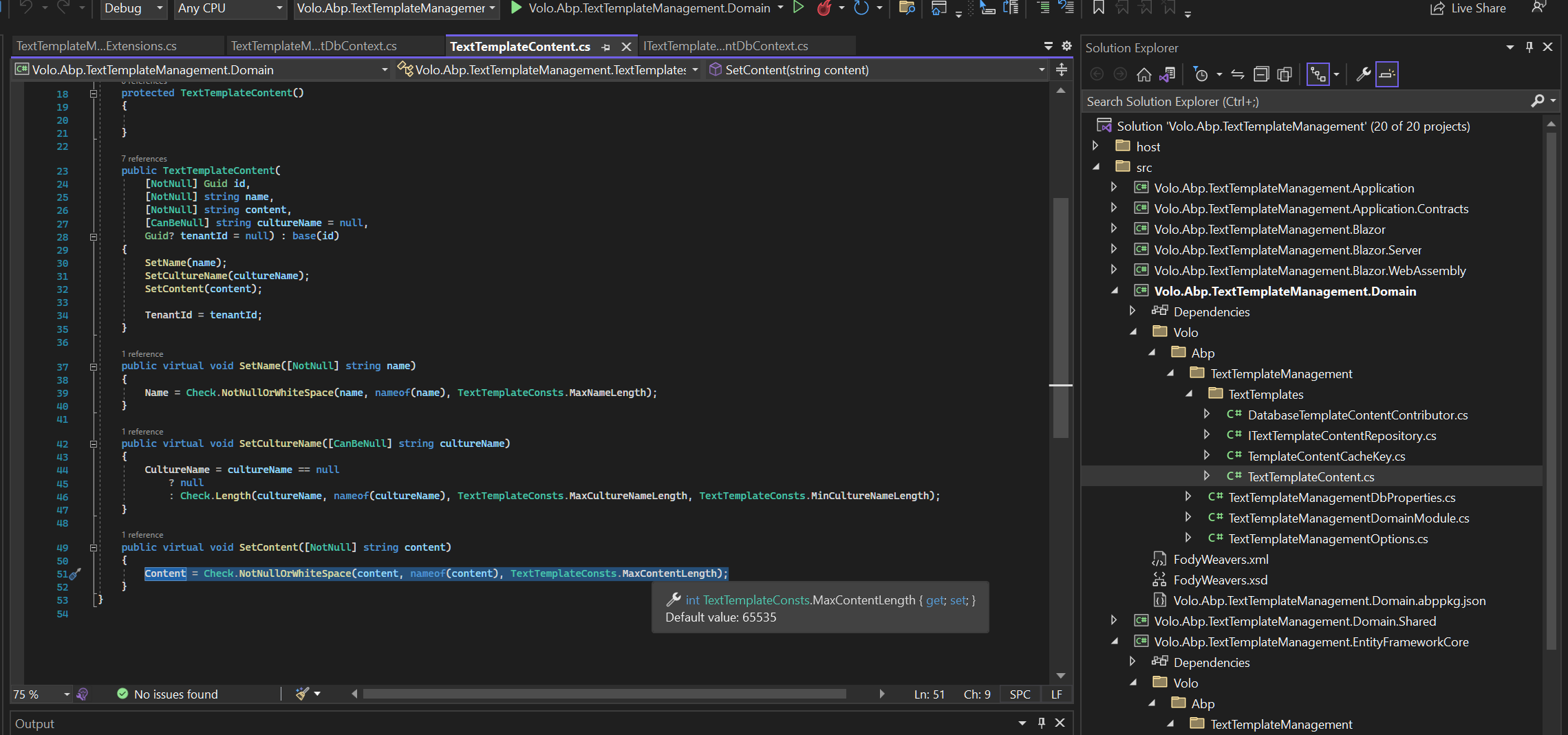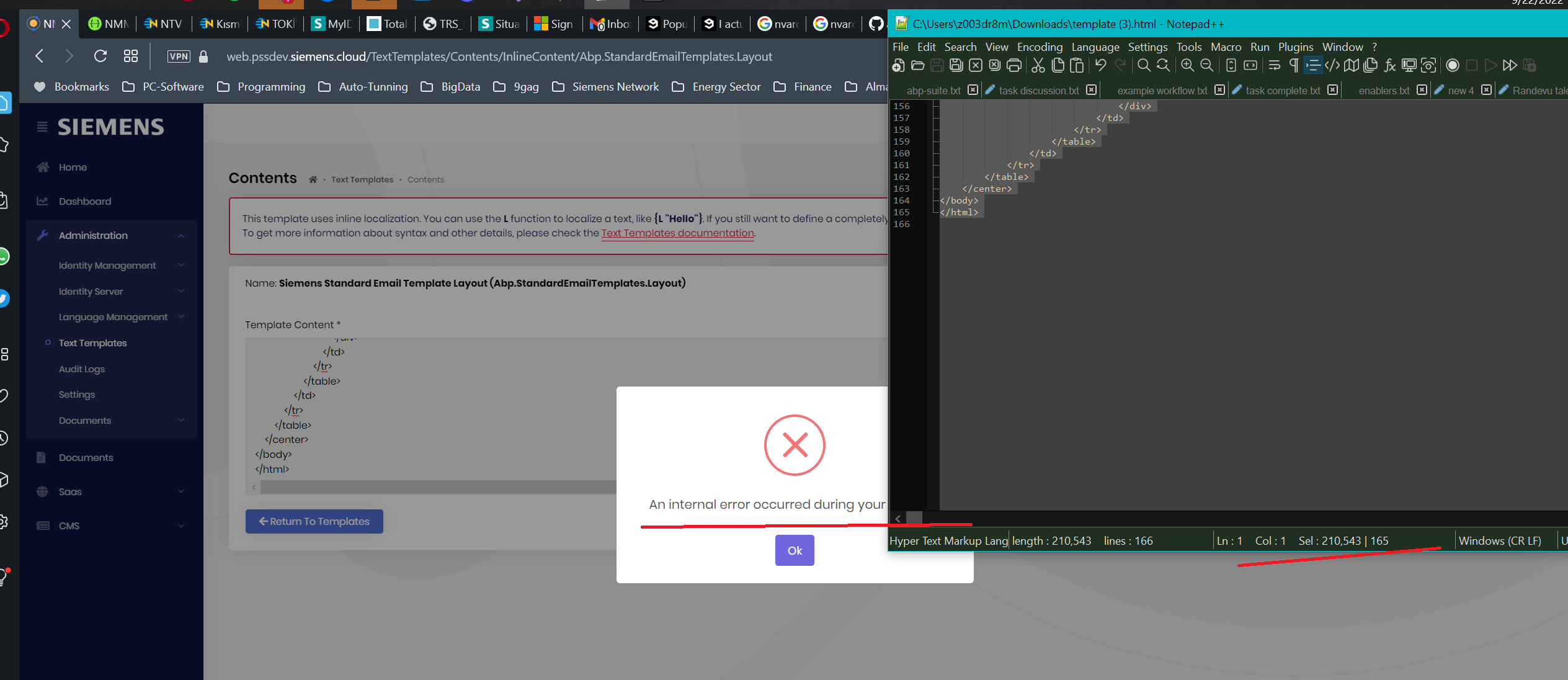Activities of "raif"
Check the docs before asking a question: https://docs.abp.io/en/abp/latest/API/API-Versioning https://docs.abp.io/en/abp/7.3/UI/AspNetCore/Data-Tables
Check the samples to see the basic tasks: https://github.com/abpframework/abp-samples/tree/master/Api-Versioning [This example doesn't show how to integrate api versiong with Datatables ]
- ABP Framework version: v7.3.1
- UI Type: MVC /
- Database System: EF Core (SQL Server)
- Tiered (for MVC) or Auth Server Separated (for Angular): ye
- Exception message and full stack trace:
- Request did not specify a service API version, but multiple candidate actions were found. Candidate actions: Siemens.PSSX.Odms.Models.v130.ModelController.GetListAsync (Siemens.PSSX.Odms.HttpApi) Siemens.PSSX.Odms.Models.v131.ModelController.GetListAsync (Siemens.PSSX.Odms.HttpApi)
We have more than one version of one of our APIs.
We can easily see the versions through the Swagger interface and working as intended.
JS proxy configuration from .Web project as shown below;
(function(){
abp.utils.createNamespace(window, 'siemens.pSSX.odms.models.v130.model');
... ///
siemens.pSSX.odms.models.v130.model.getList = function(input, ajaxParams) {
var api_version = api_version ? api_version : '13.0';
return abp.ajax($.extend(true, {
url: abp.appPath + 'api/odms/models' + abp.utils.buildQueryString([{ name: 'filterText', value: input.filterText }, { name: 'name', value: input.name }, { name: 'description', value: input.description }, { name: 'serverName', value: input.serverName }, { name: 'cIMVersion', value: input.cIMVersion }, { name: 'creatorId', value: input.creatorId }, { name: 'creationTimeMin', value: input.creationTimeMin }, { name: 'creationTimeMax', value: input.creationTimeMax }, { name: 'lastModifierId', value: input.lastModifierId }, { name: 'lastModificationTimeMin', value: input.lastModificationTimeMin }, { name: 'lastModificationTimeMax', value: input.lastModificationTimeMax }, { name: 'sorting', value: input.sorting }, { name: 'skipCount', value: input.skipCount }, { name: 'maxResultCount', value: input.maxResultCount }, { name: 'api-version', value: input.api_version }]) + '',
type: 'GET'
}, ajaxParams));
};
})();
(function(){
abp.utils.createNamespace(window, 'siemens.pSSX.odms.models.v131.model');
siemens.pSSX.odms.models.v131.model.getList = function(input, ajaxParams) {
var api_version = api_version ? api_version : '13.1';
return abp.ajax($.extend(true, {
url: abp.appPath + 'api/odms/models' + abp.utils.buildQueryString([{ name: 'filterText', value: input.filterText }, { name: 'name', value: input.name }, { name: 'description', value: input.description }, { name: 'serverName', value: input.serverName }, { name: 'cIMVersion', value: input.cIMVersion }, { name: 'creatorId', value: input.creatorId }, { name: 'creationTimeMin', value: input.creationTimeMin }, { name: 'creationTimeMax', value: input.creationTimeMax }, { name: 'lastModifierId', value: input.lastModifierId }, { name: 'lastModificationTimeMin', value: input.lastModificationTimeMin }, { name: 'lastModificationTimeMax', value: input.lastModificationTimeMax }, { name: 'sorting', value: input.sorting }, { name: 'skipCount', value: input.skipCount }, { name: 'maxResultCount', value: input.maxResultCount }, { name: 'api-version', value: input.api_version }]) + '',
type: 'GET'
}, ajaxParams));
};
})();
For the sake of simplicity, two different MVC UI were designed for two different API versions.
var l = abp.localization.getResource("Odms");
var modelService = siemens.pSSX.odms.models.v130.model;
var getFilter = function () {
return {
filterText: $("#FilterText").val(),
name: $("#NameFilter").val(),
description: $("#DescriptionFilter").val(),
serverName: $("#ServerNameFilter").val(),
cIMVersion: $("#CIMVersionFilter").val(),
creatorId: $("#ServerNameFilter").val(),
creationTimeMin: $("#CreationTimeFilterMin").val(),
creationTimeMax: $("#CreationTimeFilterMax").val(),
lastModifierId: $("#ServerNameFilter").val(),
lastModificationTimeMin: $("#LastModificationTimeFilterMin").val(),
lastModificationTimeMax: $("#LastModificationTimeFilterMax").val(),
};
};
var dataTable = $("#ModelsTable").DataTable(abp.libs.datatables.normalizeConfiguration({
processing: true,
serverSide: true,
paging: true,
searching: false,
scrollX: true,
autoWidth: false,
scrollCollapse: true,
order: [[1, "asc"]],
ajax: **abp.libs.datatables.createAjax(modelService.getList, getFilter),**
columnDefs: [
{
... ///
}
]
}));
abp.libs.datatables.createAjax(modelService.getList, getFilter),
How can we specify a service API version when creating ajax ?
Log: 2023-09-18 20:21:27.944 +02:00 [INF] Request did not specify a service API version, but multiple candidate actions were found. Candidate actions: Siemens.PSSX.Odms.Models.v130.ModelController.GetListAsync (Siemens.PSSX.Odms.HttpApi) Siemens.PSSX.Odms.Models.v131.ModelController.GetListAsync (Siemens.PSSX.Odms.HttpApi)
- ABP Framework version: v7.3.2
- UI Type: MVC
- Database System: EF Core SQL Server
- Tiered (for MVC) or Auth Server Separated (for Angular): yes
context.Services.AddAuthentication()
//.AddAbpOpenIdConnect("myAuthSchema", "myAuth AD", options =>
.AddOpenIdConnect("myAuthSchema", "myAuth AD", options =>
{
options.Authority = configuration["AzureAd:Authority"].EnsureEndsWith('/') + configuration["AzureAd:TenantId"].EnsureEndsWith('/') + "v2.0".TrimEnd('/');
options.MetadataAddress = configuration["AzureAd:MetadataAddress"].EnsureEndsWith('/') + configuration["AzureAd:TenantId"].EnsureEndsWith('/') + "v2.0".EnsureEndsWith('/') + ".well-known/openid-configuration";
options.ResponseType = OpenIdConnectResponseType.CodeIdToken;
options.ClientId = configuration["AzureAd:ClientId"];
options.ClientSecret = configuration["AzureAd:ClientSecret"];
options.UsePkce = true;
options.GetClaimsFromUserInfoEndpoint = true;
options.TokenValidationParameters = new TokenValidationParameters()
{
ValidateIssuer = true,
};
options.TokenValidationParameters.ValidIssuers = new[]
{
configuration["AzureAd:MetadataAddress"],
configuration["AzureAd:Authority"]
};
options.Scope.Add("openid");
options.Scope.Add("profile");
options.Scope.Add("offline_access");
options.Scope.Add("email");
});
.WithDynamicOptions < OpenIdConnectOptions, OpenIdConnectHandler > (
"myAuthSchema",
options =>
{
options.WithProperty(x => x.ClientId);
options.WithProperty(x => x.ClientSecret, isSecret: true);
}
);
I would like to provide ClientId and ClientSecret values via Account External Provider Settings
/api/account/external-provider endpoint keeps returning only Google, Twitter and Microsoft values
I also tried to extend provider list via AbpExternalProviderOptions but no luck
context.Services.Configure < AbpExternalProviderOptions > (options =>
{
options.Definitions.Add(new ExternalProviderDefinition()
{
Name = "Test",
Properties = new List < ExternalProviderDefinitionProperty >()
});
});
What am i missing ?
- ABP Framework version: v7.0.2
- UI type: MVC
- DB provider: EF Core
- Tiered (MVC) or Identity Server Separated (Angular): yes
Hello, We can load module classes as plug-ins without adding reference to project. The relevant explanation is https://docs.abp.io/en/abp/latest/PlugIn-Modules located at here.
Where should we define MyPlugInDemoWebModule class in this example?
using Microsoft.AspNetCore.Builder;
using Microsoft.Extensions.DependencyInjection;
using Volo.Abp.Modularity.PlugIns;
namespace MyPlugInDemo.Web
{
public class Startup
{
public void ConfigureServices(IServiceCollection services)
{
services.AddApplication<MyPlugInDemoWebModule>(options =>
{
options.PlugInSources.AddFolder(@"D:\Temp\MyPlugIns");
});
}
public void Configure(IApplicationBuilder app)
{
app.InitializeApplication();
}
}
}
This sample code does not seem updated.
Can we replace ConfigureServices(IServiceCollection services) part with
public override void ConfigureServices(ServiceConfigurationContext context)
{
}
and Configure(IApplicationBuilder app) part with
public override void OnApplicationInitialization(ApplicationInitializationContext context)
{
var app = context.GetApplicationBuilder();
app.InitializeApplication();
}
More importantly, Can you share an example where we consume a service in a project that we did add as reference
For example, I want to call MyService : IMyService, ITransientDependency that we created in the plug-in
- ABP Framework version: v7.0.2
- UI type: MVC
- DB provider: EF Core
- Tiered (MVC) or Identity Server Separated (Angular): yes
- Steps to reproduce the issue:"
- Create module from the template
- For the sake of example modify menu item
private static ApplicationMenuItem AddModuleMenuItem(MenuConfigurationContext context)
{
var l = context.GetLocalizer<TestModuleResource>();
var moduleMenu = new ApplicationMenuItem(
TestModuleMenus.Prefix,
displayName: l["Menu:TestModule"],
"~/TestModule",
icon: "fa fa-globe");
//Add main menu items.
context.Menu.Items.AddIfNotContains(moduleMenu);
return moduleMenu;
}
I believe that it is related with virtual file configuration of the Web.Host template
 File path needs to be Domain.Shared not Domain
File path needs to be Domain.Shared not Domain
- ABP Framework version: v7.0.2
- UI type: MVC
- DB provider: EF Core
- Tiered (MVC) or Identity Server Separated (Angular): yes
- Exception message and stack trace: *Autofac.Core.Registration.ComponentNotRegisteredException: The requested service 'Volo.Abp.Account.IAccountSettingsAppService' has not been registered. To avoid this exception, either register a component to provide the service, check for service registration using IsRegistered(), or use the ResolveOptional() method to resolve an optional dependency. at Autofac.ResolutionExtensions.ResolveService(IComponentContext context, Service service, IEnumerable`1 parameters) at Microsoft.Extensions.DependencyInjection.ServiceProviderServiceExtensions.GetRequiredService[T](IServiceProvider provider) at Volo.Abp.Account.Admin.Web.Settings.AccountSettingManagementPageContributor.ConfigureAsync(SettingPageCreationContext context) at Volo.Abp.SettingManagement.Web.Pages.SettingManagement.SettingPageContributorManager.ConfigureAsync() at Volo.Abp.SettingManagement.Web.Pages.SettingManagement.IndexModel.OnGetAsync() at Microsoft.AspNetCore.Mvc.RazorPages.Infrastructure.ExecutorFactory.GenericTaskHandlerMethod.Convert[T](Object taskAsObject) at Microsoft.AspNetCore.Mvc.RazorPages.Infrastructure.ExecutorFactory.GenericTaskHandlerMethod.Execute(Object receiver, Object[] arguments) at Microsoft.AspNetCore.Mvc.RazorPages.Infrastructure.PageActionInvoker.InvokeHandlerMethodAsync() at Microsoft.AspNetCore.Mvc.RazorPages.Infrastructure.PageActionInvoker.InvokeNextPageFilterAsync() at Microsoft.AspNetCore.Mvc.RazorPages.Infrastructure.PageActionInvoker.Rethrow(PageHandlerExecutedContext context) at Microsoft.AspNetCore.Mvc.RazorPages.Infrastructure.PageActionInvoker.Next(State& next, Scope& scope, Object& state, Boolean& isCompleted) at Microsoft.AspNetCore.Mvc.RazorPages.Infrastructure.PageActionInvoker.InvokeInnerFilterAsync() at Microsoft.AspNetCore.Mvc.Infrastructure.ResourceInvoker.
- Steps to reproduce the issue:
- Create a new module from template
- Login with admin user
- Hit the settings
Most possible it is due to missing Volo.Abp.Account.Pro.Admin.HttpApi.Client package at .Web.Host template
- ABP Framework version: v7.0.2
- UI type: MVC
- DB provider: EF Core
- Tiered (MVC) or Identity Server Separated (Angular): yes
- Steps to reproduce the issue:"
- Create a new module from template
- Disable redis by updating appsettings.json
- Use Web.Host for ui
- Wait 30 min
 Menu items are going to disappear, most possible due to expired token.
Menu items are going to disappear, most possible due to expired token.
Is it related with https://support.abp.io/QA/Questions/4677/User-lost-credentials-after-30min-without-activity or https://github.com/abpframework/abp/issues/14068
- ABP Framework version: v5.3.3
- UI type: MVC /
- DB provider: EF Core
- Tiered (MVC) or Identity Server Separated (Angular): yes
- Exception message and stack trace: The database operation was expected to affect 1 row(s), but actually affected 0 row(s); data may have been modified or deleted since entities were loaded. See http://go.microsoft.com/fwlink/?LinkId=527962 for information on understanding and handling optimistic concurrency exceptions.
Volo.Abp.Data.AbpDbConcurrencyException: The database operation was expected to affect 1 row(s), but actually affected 0 row(s); data may have been modified or deleted since entities were loaded. See http://go.microsoft.com/fwlink/?LinkId=527962 for information on understanding and handling optimistic concurrency exceptions.
---> Microsoft.EntityFrameworkCore.DbUpdateConcurrencyException: The database operation was expected to affect 1 row(s), but actually affected 0 row(s); data may have been modified or deleted since entities were loaded. See http://go.microsoft.com/fwlink/?LinkId=527962 for information on understanding and handling optimistic concurrency exceptions.
at Microsoft.EntityFrameworkCore.Update.AffectedCountModificationCommandBatch.ThrowAggregateUpdateConcurrencyException(Int32 commandIndex, Int32 expectedRowsAffected, Int32 rowsAffected)
at Microsoft.EntityFrameworkCore.Update.AffectedCountModificationCommandBatch.ConsumeResultSetWithoutPropagationAsync(Int32 commandIndex, RelationalDataReader reader, CancellationToken cancellationToken)
at Microsoft.EntityFrameworkCore.Update.AffectedCountModificationCommandBatch.ConsumeAsync(RelationalDataReader reader, CancellationToken cancellationToken)
at Microsoft.EntityFrameworkCore.Update.ReaderModificationCommandBatch.ExecuteAsync(IRelationalConnection connection, CancellationToken cancellationToken)
at Microsoft.EntityFrameworkCore.Update.ReaderModificationCommandBatch.ExecuteAsync(IRelationalConnection connection, CancellationToken cancellationToken)
at Microsoft.EntityFrameworkCore.Update.Internal.BatchExecutor.ExecuteAsync(IEnumerable
1 commandBatches, IRelationalConnection connection, CancellationToken cancellationToken) at Microsoft.EntityFrameworkCore.Update.Internal.BatchExecutor.ExecuteAsync(IEnumerable1 commandBatches, IRelationalConnection connection, CancellationToken cancellationToken) at Microsoft.EntityFrameworkCore.Update.Internal.BatchExecutor.ExecuteAsync(IEnumerable1 commandBatches, IRelationalConnection connection, CancellationToken cancellationToken) at Microsoft.EntityFrameworkCore.ChangeTracking.Internal.StateManager.SaveChangesAsync(IList1 entriesToSave, CancellationToken cancellationToken) at Microsoft.EntityFrameworkCore.ChangeTracking.Internal.StateManager.SaveChangesAsync(StateManager stateManager, Boolean acceptAllChangesOnSuccess, CancellationToken cancellationToken) at Microsoft.EntityFrameworkCore.SqlServer.Storage.Internal.SqlServerExecutionStrategy.ExecuteAsync[TState,TResult](TState state, Func4 operation, Func4 verifySucceeded, CancellationToken cancellationToken) at Microsoft.EntityFrameworkCore.DbContext.SaveChangesAsync(Boolean acceptAllChangesOnSuccess, CancellationToken cancellationToken) at Microsoft.EntityFrameworkCore.DbContext.SaveChangesAsync(Boolean acceptAllChangesOnSuccess, CancellationToken cancellationToken) at Volo.Abp.EntityFrameworkCore.AbpDbContext1.SaveChangesAsync(Boolean acceptAllChangesOnSuccess, CancellationToken cancellationToken) --- End of inner exception stack trace --- at Volo.Abp.EntityFrameworkCore.AbpDbContext1.SaveChangesAsync(Boolean acceptAllChangesOnSuccess, CancellationToken cancellationToken) at Volo.Abp.Uow.UnitOfWork.SaveChangesAsync(CancellationToken cancellationToken) at Volo.Abp.Uow.UnitOfWork.CompleteAsync(CancellationToken cancellationToken) at Volo.Abp.AspNetCore.Mvc.Uow.AbpUowActionFilter.OnActionExecutionAsync(ActionExecutingContext context, ActionExecutionDelegate next) at Microsoft.AspNetCore.Mvc.Infrastructure.ControllerActionInvoker.<InvokeNextActionFilterAsync>g__Awaited|10_0(ControllerActionInvoker invoker, Task lastTask, State next, Scope scope, Object state, Boolean isCompleted) at Microsoft.AspNetCore.Mvc.Infrastructure.ControllerActionInvoker.Rethrow(ActionExecutedContextSealed context) at Microsoft.AspNetCore.Mvc.Infrastructure.ControllerActionInvoker.Next(State& next, Scope& scope, Object& state, Boolean& isCompleted) at Microsoft.AspNetCore.Mvc.Infrastructure.ControllerActionInvoker.<InvokeInnerFilterAsync>g__Awaited|13_0(ControllerActionInvoker invoker, Task lastTask, State next, Scope scope, Object state, Boolean isCompleted) at Microsoft.AspNetCore.Mvc.Infrastructure.ResourceInvoker.<InvokeNextExceptionFilterAsync>g__Awaited|26_0(ResourceInvoker invoker, Task lastTask, State next, Scope scope, Object state, Boolean isCompleted) - Steps to reproduce the issue:"
- Try to submit concurrent update to the database
There is a nice documentation and blog post on how to check concurrency (https://docs.abp.io/en/abp/latest/Concurrency-Check), but there is no example on how to resolve conflicts manually. I don't understand how we can access the "values" (values on db, submitted data etc) in case of conflict.
The SaveChangesAsync() function throws AbpDbConcurrencyException not DbUpdateConcurrencyException
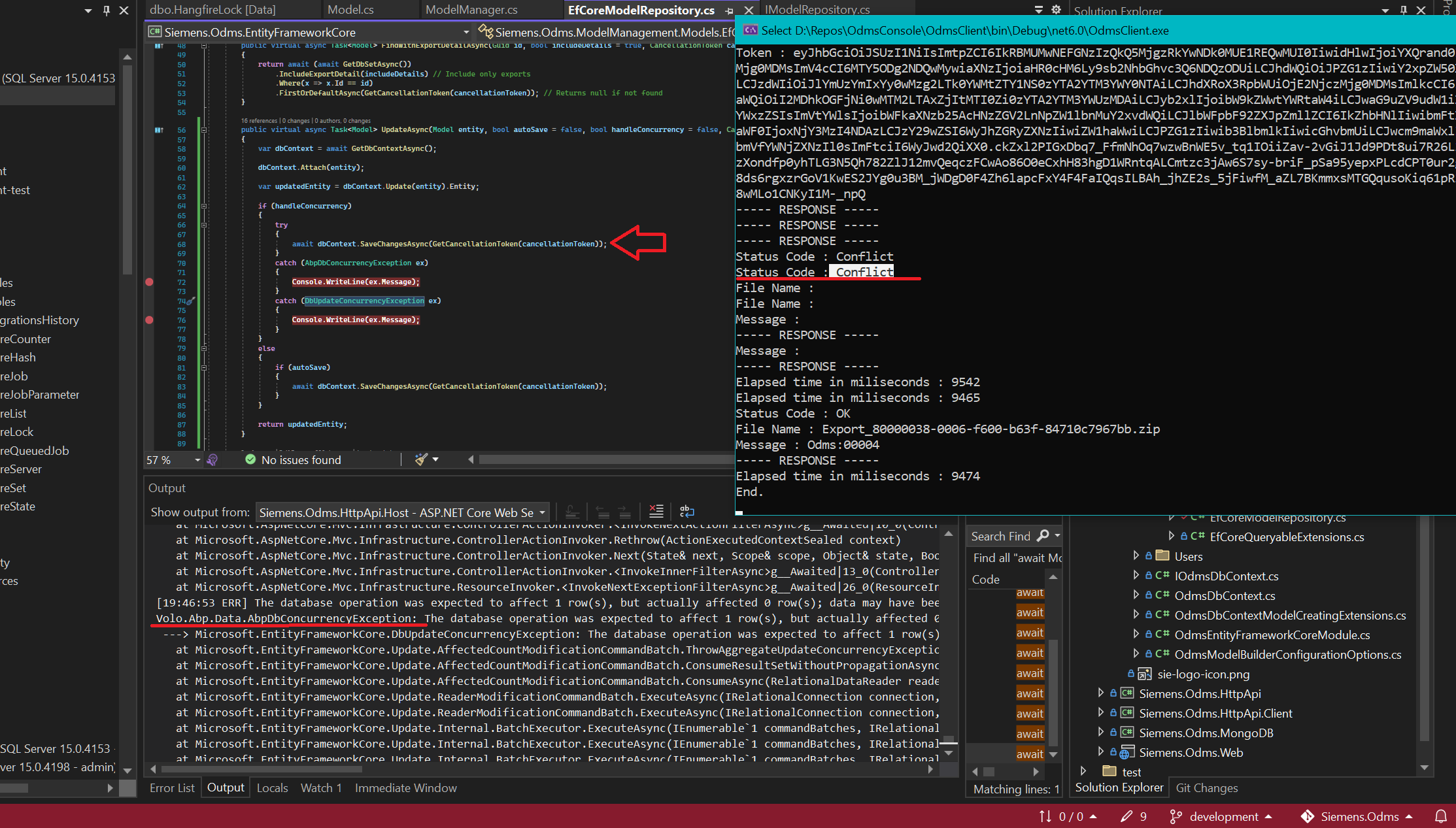
The AbpDbConcurrencyException class does not derive from the DbUpdateConcurrencyException class.
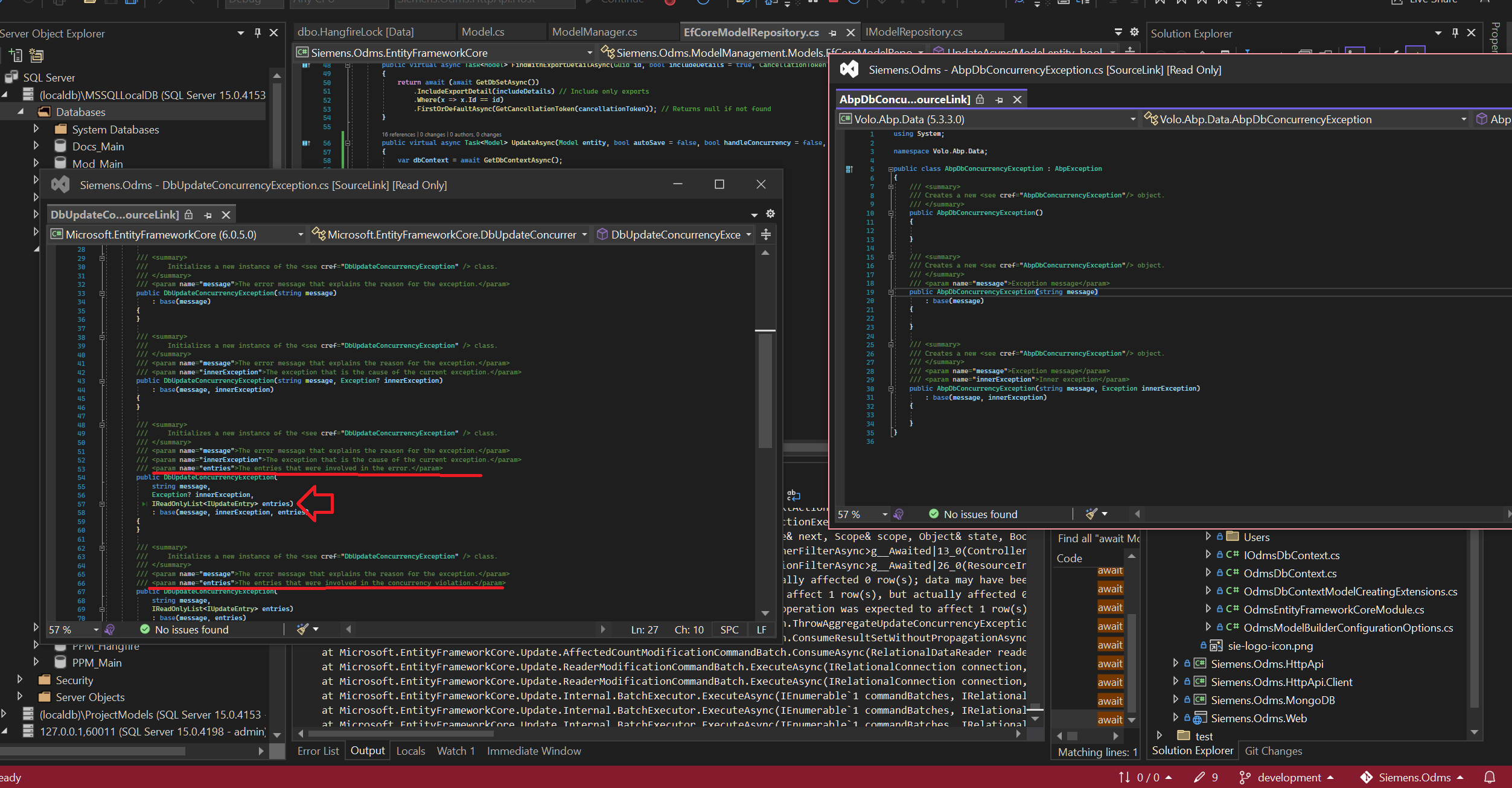
For this reason, I cannot access the Current/Original/Database values of the entity. (https://learn.microsoft.com/en-us/ef/core/saving/concurrency#resolving-concurrency-conflicts)
Can you share an example about the resolving concurrency conflicts ? Existing framework documentation doesn't provide any info resolving concurrency.
- ABP Framework version: v5.3.3
- UI type: MVC
- DB provider: EF Core
- Tiered (MVC) or Identity Server Separated (Angular): yes
- Exception message and stack trace: Volo.Abp.Cli.CliUsageException: Use command: abp new Acme.BookStore -v version at Volo.Abp.Cli.ProjectBuilding.AbpIoSourceCodeStore.GetAsync(String name, String type, String version, String templateSource, Boolean includePreReleases) in D:\ci\Jenkins\workspace\abp-commercial-release\abp\framework\src\Volo.Abp.Cli.Core\Volo\Abp\Cli\ProjectBuilding\AbpIoSourceCodeStore.cs:line 80 at Volo.Abp.Cli.ProjectBuilding.TemplateProjectBuilder.BuildAsync(ProjectBuildArgs args) in D:\ci\Jenkins\workspace\abp-commercial-release\abp\framework\src\Volo.Abp.Cli.Core\Volo\Abp\Cli\ProjectBuilding\TemplateProjectBuilder.cs:line 57 at Volo.Abp.Cli.Commands.NewCommand.ExecuteAsync(CommandLineArgs commandLineArgs) in D:\ci\Jenkins\workspace\abp-commercial-release\abp\framework\src\Volo.Abp.Cli.Core\Volo\Abp\Cli\Commands\NewCommand.cs:line 73 at Volo.Abp.Suite.Areas.AbpSuite.CrudPageGenerator.Services.SolutionService.CreateSolutionAsync(CreateSolutionModel input) at lambda_method1668(Closure , Object ) at Microsoft.AspNetCore.Mvc.Infrastructure.ActionMethodExecutor.AwaitableObjectResultExecutor.Execute(IActionResultTypeMapper mapper, ObjectMethodExecutor executor, Object controller, Object[] arguments) at Microsoft.AspNetCore.Mvc.Infrastructure.ControllerActionInvoker.<InvokeActionMethodAsync>g__Awaited|12_0(ControllerActionInvoker invoker, ValueTask`1 actionResultValueTask) at Microsoft.AspNetCore.Mvc.Infrastructure.ControllerActionInvoker.
- Steps to reproduce the issue:"
- Perform any action which requires to check license such as creating a new project via abp suite.
ABP-LIC-0013 - License exception: ABP-LIC-0023: An error occured while calling the license server! The input is not a valid Base-64 string as it contains a non-base 64 character, more than two padding characters, or an illegal character among the padding characters. Error occured while getting the latest version from https://abp.io/api/download/template/get-version/ : Remote server returns '403-Forbidden'. Message: Pro templates require a commercial license! Should login to be able to download a pro template.
And also is this UI issue ? Why we can't set status to non-private ?

ABP Framework version: v5.3.3
UI type: MVC
DB provider: EF Core
Tiered (MVC) or Identity Server Separated (Angular): yes
Exception message and stack trace: 2022-09-21 12:35:43.088 +00:00 [ERR] content length must be equal to or lower than 65535! (Parameter 'content') System.ArgumentException: content length must be equal to or lower than 65535! (Parameter 'content') at Volo.Abp.Check.NotNullOrWhiteSpace(String value, String parameterName, Int32 maxLength, Int32 minLength) in D:\ci\Jenkins\workspace\abp-framework-release\abp\framework\src\Volo.Abp.Core\Volo\Abp\Check.cs:line 82 at Volo.Abp.TextTemplateManagement.TextTemplates.TextTemplateContent.SetContent(String content) at Volo.Abp.TextTemplateManagement.TextTemplates.TextTemplateContent..ctor(Guid id, String name, String content, String cultureName, Nullable
1 tenantId) at Volo.Abp.TextTemplateManagement.TextTemplates.TemplateContentAppService.UpdateAsync(UpdateTemplateContentInput input) at Castle.DynamicProxy.AsyncInterceptorBase.ProceedAsynchronous[TResult](IInvocation invocation, IInvocationProceedInfo proceedInfo) at Volo.Abp.Castle.DynamicProxy.CastleAbpMethodInvocationAdapterWithReturnValue1.ProceedAsync() in D:\ci\Jenkins\workspace\abp-framework-release\abp\framework\src\Volo.Abp.Castle.Core\Volo\Abp\Castle\DynamicProxy\CastleAbpMethodInvocationAdapterWithReturnValue.cs:line 25 at Volo.Abp.Authorization.AuthorizationInterceptor.InterceptAsync(IAbpMethodInvocation invocation) in D:\ci\Jenkins\workspace\abp-framework-release\abp\framework\src\Volo.Abp.Authorization\Volo\Abp\Authorization\AuthorizationInterceptor.cs:line 20 at Volo.Abp.Castle.DynamicProxy.CastleAsyncAbpInterceptorAdapter1.InterceptAsync[TResult](IInvocation invocation, IInvocationProceedInfo proceedInfo, Func3 proceed) in D:\ci\Jenkins\workspace\abp-framework-release\abp\framework\src\Volo.Abp.Castle.Core\Volo\Abp\Castle\DynamicProxy\CastleAsyncAbpInterceptorAdapter.cs:line 34 at Castle.DynamicProxy.AsyncInterceptorBase.ProceedAsynchronous[TResult](IInvocation invocation, IInvocationProceedInfo proceedInfo) at Volo.Abp.Castle.DynamicProxy.CastleAbpMethodInvocationAdapterWithReturnValue1.ProceedAsync() in D:\ci\Jenkins\workspace\abp-framework-release\abp\framework\src\Volo.Abp.Castle.Core\Volo\Abp\Castle\DynamicProxy\CastleAbpMethodInvocationAdapterWithReturnValue.cs:line 25 at Volo.Abp.GlobalFeatures.GlobalFeatureInterceptor.InterceptAsync(IAbpMethodInvocation invocation) in D:\ci\Jenkins\workspace\abp-framework-release\abp\framework\src\Volo.Abp.GlobalFeatures\Volo\Abp\GlobalFeatures\GlobalFeatureInterceptor.cs:line 26 at Volo.Abp.Castle.DynamicProxy.CastleAsyncAbpInterceptorAdapter1.InterceptAsync[TResult](IInvocation invocation, IInvocationProceedInfo proceedInfo, Func3 proceed) in D:\ci\Jenkins\workspace\abp-framework-release\abp\framework\src\Volo.Abp.Castle.Core\Volo\Abp\Castle\DynamicProxy\CastleAsyncAbpInterceptorAdapter.cs:line 34 at Castle.DynamicProxy.AsyncInterceptorBase.ProceedAsynchronous[TResult](IInvocation invocation, IInvocationProceedInfo proceedInfo) at Volo.Abp.Castle.DynamicProxy.CastleAbpMethodInvocationAdapterWithReturnValue1.ProceedAsync() in D:\ci\Jenkins\workspace\abp-framework-release\abp\framework\src\Volo.Abp.Castle.Core\Volo\Abp\Castle\DynamicProxy\CastleAbpMethodInvocationAdapterWithReturnValue.cs:line 25 at Volo.Abp.Auditing.AuditingInterceptor.ProceedByLoggingAsync(IAbpMethodInvocation invocation, IAuditingHelper auditingHelper, IAuditLogScope auditLogScope) in D:\ci\Jenkins\workspace\abp-framework-release\abp\framework\src\Volo.Abp.Auditing\Volo\Abp\Auditing\AuditingInterceptor.cs:line 103 at Volo.Abp.Auditing.AuditingInterceptor.InterceptAsync(IAbpMethodInvocation invocation) in D:\ci\Jenkins\workspace\abp-framework-release\abp\framework\src\Volo.Abp.Auditing\Volo\Abp\Auditing\AuditingInterceptor.cs:line 49 at Volo.Abp.Castle.DynamicProxy.CastleAsyncAbpInterceptorAdapter1.InterceptAsync[TResult](IInvocation invocation, IInvocationProceedInfo proceedInfo, Func3 proceed) in D:\ci\Jenkins\workspace\abp-framework-release\abp\framework\src\Volo.Abp.Castle.Core\Volo\Abp\Castle\DynamicProxy\CastleAsyncAbpInterceptorAdapter.cs:line 34 at Castle.DynamicProxy.AsyncInterceptorBase.ProceedAsynchronous[TResult](IInvocation invocation, IInvocationProceedInfo proceedInfo) at Volo.Abp.Castle.DynamicProxy.CastleAbpMethodInvocationAdapterWithReturnValue1.ProceedAsync() in D:\ci\Jenkins\workspace\abp-framework-release\abp\framework\src\Volo.Abp.Castle.Core\Volo\Abp\Castle\DynamicProxy\CastleAbpMethodInvocationAdapterWithReturnValue.cs:line 25 at Volo.Abp.Features.FeatureInterceptor.InterceptAsync(IAbpMethodInvocation invocation) in D:\ci\Jenkins\workspace\abp-framework-release\abp\framework\src\Volo.Abp.Features\Volo\Abp\Features\FeatureInterceptor.cs:line 29 at Volo.Abp.Castle.DynamicProxy.CastleAsyncAbpInterceptorAdapter1.InterceptAsync[TResult](IInvocation invocation, IInvocationProceedInfo proceedInfo, Func3 proceed) in D:\ci\Jenkins\workspace\abp-framework-release\abp\framework\src\Volo.Abp.Castle.Core\Volo\Abp\Castle\DynamicProxy\CastleAsyncAbpInterceptorAdapter.cs:line 34 at Castle.DynamicProxy.AsyncInterceptorBase.ProceedAsynchronous[TResult](IInvocation invocation, IInvocationProceedInfo proceedInfo) at Volo.Abp.Castle.DynamicProxy.CastleAbpMethodInvocationAdapterWithReturnValue1.ProceedAsync() in D:\ci\Jenkins\workspace\abp-framework-release\abp\framework\src\Volo.Abp.Castle.Core\Volo\Abp\Castle\DynamicProxy\CastleAbpMethodInvocationAdapterWithReturnValue.cs:line 25 at Volo.Abp.Validation.ValidationInterceptor.InterceptAsync(IAbpMethodInvocation invocation) in D:\ci\Jenkins\workspace\abp-framework-release\abp\framework\src\Volo.Abp.Validation\Volo\Abp\Validation\ValidationInterceptor.cs:line 20 at Volo.Abp.Castle.DynamicProxy.CastleAsyncAbpInterceptorAdapter1.InterceptAsync[TResult](IInvocation invocation, IInvocationProceedInfo proceedInfo, Func3 proceed) in D:\ci\Jenkins\workspace\abp-framework-release\abp\framework\src\Volo.Abp.Castle.Core\Volo\Abp\Castle\DynamicProxy\CastleAsyncAbpInterceptorAdapter.cs:line 34 at Castle.DynamicProxy.AsyncInterceptorBase.ProceedAsynchronous[TResult](IInvocation invocation, IInvocationProceedInfo proceedInfo) at Volo.Abp.Castle.DynamicProxy.CastleAbpMethodInvocationAdapterWithReturnValue1.ProceedAsync() in D:\ci\Jenkins\workspace\abp-framework-release\abp\framework\src\Volo.Abp.Castle.Core\Volo\Abp\Castle\DynamicProxy\CastleAbpMethodInvocationAdapterWithReturnValue.cs:line 25 at Volo.Abp.Uow.UnitOfWorkInterceptor.InterceptAsync(IAbpMethodInvocation invocation) in D:\ci\Jenkins\workspace\abp-framework-release\abp\framework\src\Volo.Abp.Uow\Volo\Abp\Uow\UnitOfWorkInterceptor.cs:line 53 at Volo.Abp.Castle.DynamicProxy.CastleAsyncAbpInterceptorAdapter1.InterceptAsync[TResult](IInvocation invocation, IInvocationProceedInfo proceedInfo, Func3 proceed) in D:\ci\Jenkins\workspace\abp-framework-release\abp\framework\src\Volo.Abp.Castle.Core\Volo\Abp\Castle\DynamicProxy\CastleAsyncAbpInterceptorAdapter.cs:line 34 at Volo.Abp.TextTemplateManagement.TextTemplates.TemplateContentController.UpdateAsync(UpdateTemplateContentInput input) at lambda_method13416(Closure , Object ) at Microsoft.AspNetCore.Mvc.Infrastructure.ActionMethodExecutor.AwaitableObjectResultExecutor.Execute(IActionResultTypeMapper mapper, ObjectMethodExecutor executor, Object controller, Object[] arguments) at Microsoft.AspNetCore.Mvc.Infrastructure.ControllerActionInvoker.<InvokeActionMethodAsync>g__Awaited|12_0(ControllerActionInvoker invoker, ValueTask1 actionResultValueTask) at Microsoft.AspNetCore.Mvc.Infrastructure.ControllerActionInvoker.<InvokeNextActionFilterAsync>g__Awaited|10_0(ControllerActionInvoker invoker, Task lastTask, State next, Scope scope, Object state, Boolean isCompleted) at Microsoft.AspNetCore.Mvc.Infrastructure.ControllerActionInvoker.Rethrow(ActionExecutedContextSealed context) at Microsoft.AspNetCore.Mvc.Infrastructure.ControllerActionInvoker.Next(State& next, Scope& scope, Object& state, Boolean& isCompleted) at Microsoft.AspNetCore.Mvc.Infrastructure.ControllerActionInvoker.<InvokeInnerFilterAsync>g__Awaited|13_0(ControllerActionInvoker invoker, Task lastTask, State next, Scope scope, Object state, Boolean isCompleted) at Microsoft.AspNetCore.Mvc.Infrastructure.ResourceInvoker.<InvokeNextExceptionFilterAsync>g__Awaited|26_0(ResourceInvoker invoker, Task lastTask, State next, Scope scope, Object state, Boolean isCompleted)Steps to reproduce the issue:"
- Try to replace existing template with other one which has more 65535 character.
Why there is such a limit ?
- ABP Framework version: v5.2.0
- UI type: Blazor
- DB provider: EF Core
- Tiered (MVC) or Identity Server Separated (Angular): yes
- Exception message and stack trace: [11:19:59 INF] Start installing Hangfire SQL objects...
[11:20:11 WRN] An exception occurred while trying to perform the migration. Retrying...
System.Data.SqlClient.SqlException (0x80131904): Cannot open database "hangfiretest" requested by the login. The login failed.
Login failed for user 'AD001\z003dr8m'.
at System.Data.SqlClient.SqlInternalConnectionTds..ctor(DbConnectionPoolIdentity identity, SqlConnectionString connectionOptions, Object providerInfo, Boolean redirectedUserInstance, SqlConnectionString userConnectionOptions, SessionData reconnectSessionData, Boolean applyTransientFaultHandling)
at System.Data.SqlClient.SqlConnectionFactory.CreateConnection(DbConnectionOptions options, DbConnectionPoolKey poolKey, Object poolGroupProviderInfo, DbConnectionPool pool, DbConnection owningConnection, DbConnectionOptions userOptions)
at System.Data.ProviderBase.DbConnectionFactory.CreatePooledConnection(DbConnectionPool pool, DbConnection owningObject, DbConnectionOptions options, DbConnectionPoolKey poolKey, DbConnectionOptions userOptions)
at System.Data.ProviderBase.DbConnectionPool.CreateObject(DbConnection owningObject, DbConnectionOptions userOptions, DbConnectionInternal oldConnection)
at System.Data.ProviderBase.DbConnectionPool.UserCreateRequest(DbConnection owningObject, DbConnectionOptions userOptions, DbConnectionInternal oldConnection)
at System.Data.ProviderBase.DbConnectionPool.TryGetConnection(DbConnection owningObject, UInt32 waitForMultipleObjectsTimeout, Boolean allowCreate, Boolean onlyOneCheckConnection, DbConnectionOptions userOptions, DbConnectionInternal& connection)
at System.Data.ProviderBase.DbConnectionPool.TryGetConnection(DbConnection owningObject, TaskCompletionSource
1 retry, DbConnectionOptions userOptions, DbConnectionInternal& connection) at System.Data.ProviderBase.DbConnectionFactory.TryGetConnection(DbConnection owningConnection, TaskCompletionSource1 retry, DbConnectionOptions userOptions, DbConnectionInternal oldConnection, DbConnectionInternal& connection) at System.Data.ProviderBase.DbConnectionInternal.TryOpenConnectionInternal(DbConnection outerConnection, DbConnectionFactory connectionFactory, TaskCompletionSource1 retry, DbConnectionOptions userOptions) at System.Data.ProviderBase.DbConnectionClosed.TryOpenConnection(DbConnection outerConnection, DbConnectionFactory connectionFactory, TaskCompletionSource1 retry, DbConnectionOptions userOptions) at System.Data.SqlClient.SqlConnection.TryOpen(TaskCompletionSource1 retry) at System.Data.SqlClient.SqlConnection.Open() at Hangfire.SqlServer.SqlServerStorage.CreateAndOpenConnection() at Hangfire.SqlServer.SqlServerStorage.UseConnection[T](DbConnection dedicatedConnection, Func2 func) at Hangfire.SqlServer.SqlServerStorage.Initialize() ClientConnectionId:818770b2-7b19-493b-974a-ffce2693698f Error Number:4060,State:1,Class:11 - Steps to reproduce the issue:"
- Create new application by using application template
- Add Hangfire.SqlServer package for job storage persistence
- Add Volo.Abp.HangFire for AbpHangfireOptions
- Define connection string for job storage e.g :
GlobalConfiguration.Configuration
// Use custom connection string
.UseSqlServerStorage(configuration.GetConnectionString("Default"));
- Even if you try to disable it by using AbpBackgroundJobOptions and AbpBackgroundWorkerOptions options, AbpBackgroundWorkersHangfireModule and AbpBackgroundJobsHangfireModule will try to create Job Server (CreateOnlyEnqueueJobServer)
public override void ConfigureServices(ServiceConfigurationContext context)
{
var configuration = context.Services.GetConfiguration();
Configure<AbpBackgroundJobOptions>(options =>
{
options.IsJobExecutionEnabled = false;
});
Configure<AbpBackgroundWorkerOptions>(options =>
{
options.IsEnabled = false;
});
}
AbpBackgroundWorkersHangfireModule on pre application initilization stage :
public async override Task OnPreApplicationInitializationAsync(ApplicationInitializationContext context)
{
var options = context.ServiceProvider.GetRequiredService<IOptions<AbpBackgroundWorkerOptions>>().Value;
if (!options.IsEnabled)
{
var hangfireOptions = context.ServiceProvider.GetRequiredService<IOptions<AbpHangfireOptions>>().Value;
hangfireOptions.BackgroundJobServerFactory = CreateOnlyEnqueueJobServer;
}
await context.ServiceProvider
.GetRequiredService<IBackgroundWorkerManager>()
.StartAsync();
}
- GG. As you can imagine, at that stage DB is not created and Hangfire SQL intsall scripts are going to fail.
